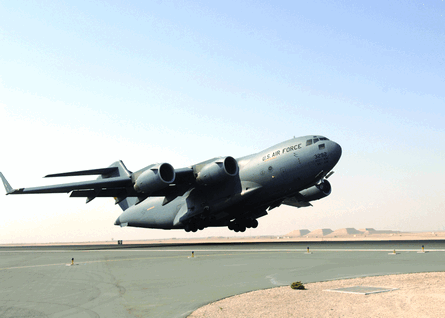Elements of Boeing's proposed upgrade package for transforming the C-17A into a more suitable theatre transport could be added piecemeal rather than in a single, $2 billion development package, a company executive says.
That detail could be a key factor for the "C-17B" concept to gain joint US Air Force and US Army approval, and, thus, to preserve the life of the production line far into the next decade.
Boeing has identified eight major upgrades required to make the C-17B a true tactical airlifter.
 |
|---|
© USAF |
The package includes higher thrust engines and double-slotted flaps for "extreme" short-field landings adding a centre main landing gear with tyre inflation and deflation an engine-out control system (EOCS) a precision landing augmentation system (PLAS) an all-weather, autonomous landing system (AALG) an opportune landing site (OLS) system and the advanced situational awareness and countermeasures system (ASACMS).
Rolling eight upgrades into a single upgrade package presents several potential risks for the Boeing proposal.
First, launching a new development programme may require the USAF to launch a lengthy requirements setting process. The same tactic may also result in a need to compete the contract.
The Airbus A400M would be available for export by 2015, and the incumbent tactical transport supplier - the Lockheed Martin C-130 team - may seek to offer a challenger.
However, Boeing is also seeking to offer the C-17B as a series of discrete upgrades to the current C-17 fleet, says Alan Baker, a Boeing business development official.
In fact, Boeing is already on contract to supply the first of the C-17B upgrades - the ASACMS defensive suite - as an upgrade in the next production lot for the C-17A.
The other four major software upgrades - EOCS, PLAS, AALG and OLS - have been developed through grants by the Air Force Research Laboratory and the Defense Advanced Research Projects Agency, says Bob Ciesla, Boeing's C-17 deputy programme manager.
Boeing is also preparing to develop prototype models to demonstrate the major structural upgrades, to include the uprated Pratt & Whitney F117 engines, the new Goodrich landing gear and double-slotted flaps.
In addition, the company has considered developing a new, all-composite wing and integrating scaled-down versions of the General Electric GEnx-1B and -2B engines currently powering the Boeing 787 and 747-8, respectively, Baker says. This upgrade, however, is considered a low probability, he adds, because it may be more cost-effective to develop an all-new aircraft.
The spiral upgrade plan, of course, requires the USAF to continue buying the C-17 in annual batches of 15 aircraft through at least 2014.
Boeing is counting on the US Congress to provide funds to buy another 15 aircraft in the fiscal year 2009 supplemental budget, raising total USAF deliveries to 220 and extending production through at least 2011.
Source: Flight International


























